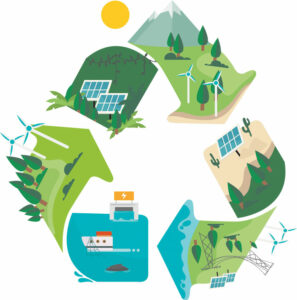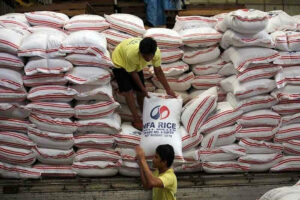A quest for reaching bigger targets

By Adrian Paul B. Conoza, Special Features Assistant Editor
With the worsening global issue of climate change and, in turn, the rising call to reduce greenhouse gas emissions, particularly carbon dioxide, the energy sector is further pushed to expand the share of renewable and cleaner sources like biomass, solar, wind, geothermal, ocean energy, hydropower in the grid.
Reflecting such push, at least initially, is the updated Philippine Energy Plan (PEP) 2020-2040 of the Department of Energy (DoE), which is highlighted by increased targets of 35% share of renewable energy (RE) in the power generation mix by 2030 and 50% share by 2040.
These targets aim to tackle the observed decline in the recent share of RE in the mix. In a report by the Philippine News Agency last November, Director Mylene C. Capongcol, officer-in-charge of DoE’s Renewable Energy Management Bureau, shared that from about 34% in 2008, the share of RE has gone down to 21%, or 21,609 gigawatt-hours (GWh), out of a total 101,756 GWh of power generated.
The 50% target for RE is part of the updated PEP’s Clean Energy Scenario (CES), under which oil, coal, and natural gas reduce their levels in the total primary energy supply (TPES) to 35.5%, 20.8%, and 11.6%, respectively, by 2040.
In comparison, the PEP revealed that as of 2020, coal served as the country’s biggest energy source, with 30.8% share of TPES, while oil had 29.2% and natural gas had 5.8%, totaling fossil fuels’ share to 65.8%. Renewables, meanwhile, increased their share to 34.2%, from 32.9% in 2019.
Moreover, the CES sets about a fourth of the power generation to come from natural gas with 26.6% share and coal with 23.1%; while solar and hydro comprise 20.6% and 18.0, respectively, by 2040. The remaining share is hoped to be contributed by geothermal, wind, biomass, and oil, altogether bringing 11.7%.
In 2020, coal power plants contributed more than a half of the power generation output at 57.2%, natural gas at 19.2%, geothermal at 10.6%, and hydropower at 7.1%. The combined generation output of solar, wind, and biomass comprised a 3.6% share of the total generation mix during the period.
The CES also aims to increase RE’s total installed capacity to 81.5 GW by the same period, translating to 68.7%. Particularly, solar’s share is pegged at 46.1 GW, wind at 11.8 GW, and 20.1 GW for hydro. Gas, on the other hand, drops to 18.9 GW.
In a BusinessWorld report last February, the DoE said that the country’s energy system is expected to add capacity of 7,910.96 megawatts (MW) by 2027, with coal-fired plants accounting for 46.68% of the capacity, natural gas 38.71%, RE 11.39%, and oil-fueled facilities 6.67%.
With 901.27 MW projected to be added to RE capacity, solar is calculated to account for 488.27 MW, hydropower 232.50 MW, geothermal 115.60 MW, and biomass 64.60 MW.
Razon-led Prime Infrastructure Capital, Inc. or Prime Infra (formerly known as Prime Infrastructure Holdings, Inc.) recognizes the PEP as the blueprint toward a more sustainable and resilient future where critical energy infrastructure are delivered with sustainability in mind — energy security, social relevance, and environmentally resilient.
“The national government’s pivot to renewable power projects is very much aligned with our business direction where sustainability is both a guiding philosophy, and a commitment to our stakeholders,” Prime Infra told BusinessWorld in an e-mail.
In line with this plan, Prime Infra said it actively seeks out opportunities to deliver clean energy projects and technologies that will support the RE landscape set out by the government for the next two decades.
“The close collaboration of government and private entities is crucial to help transition away from GHG intensive energy sources, such as coal and oil, and increase the supply of renewable and sustainable energy,” the company shared. “This is why Prime Infra will continue to pioneer power projects — as our track record shows — in line with our goal of empowering communities and fostering positive socio-economic development.”
One power infrastructure project Prime Infra is taking on to support the national government’s energy plans involves solar energy.
Terra Solar Philippines, a unit of Terra Renewables Holdings, Inc., which is a power subsidiary under Prime Infra’s control, has partnered with Solar Philippines Power Project Holdings, Inc. to develop what is claimed to be the world’s largest solar power facility.
“The solar project is envisioned to have a capacity of 2,500MW to 3,500MW, combined with 4,000 MWh (megawatt hour) to 4,500 MWh battery energy storage system (BESS) boosting the supply of renewable energy in the country,” Prime Infra said.
“Taking advantage of the steep decline in installation costs of solar panels and the improved BESS technology will allow Prime Infra to build an economically critical and socially relevant infrastructure at a scale the world has never seen before,” it added.
This facility, the company continued, will serve as a crucial part of how it will help address an anticipated heightened energy demand post-pandemic.
“Our Terra Solar project is a model of dependable renewable energy, which represents a stable price not subject to fuel imports volatility for the rest of the 20-year contract,” Prime Infra explained. “The 850 MW supply to offtaker Manila Electric Company can displace an annual consumption of approximately 1.4 million tons of coal or 930 million liters of oil. This means a reduction in both greenhouse gas emissions and import dependency for the country from 2026 to 2046.”
Prime Infra is also keen on building a hydropower project that will further contribute to the country’s RE mix. It is also poised to acquire a controlling stake in the Malampaya deep-water gas-to-power project, as natural gas is seen to contribute more to the country’s transition from expensive coal and imported fuel prices to affordable and cleaner domestic energy resources.
The company has also established a new subsidiary that will help solve municipal waste problems and minimize methane emissions from landfills. WasteFuel Philippines was established last year for a waste-to-fuel project to be developed in partnership with US-based WasteFuel Global.
“With the goal of turning waste into a valuable source of clean energy, the company is eyeing to put up by 2025 a biorefinery in Luzon that would convert municipal solid waste and agricultural feedstock into fuels for the maritime and aviation industries,” said Prime Infra.




